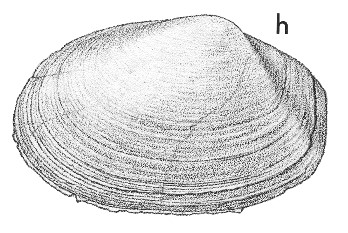
Revised descriptions of New Zealand Cenozoic Mollusca from Beu and Maxwell (1990)

 | Revised descriptions of New Zealand Cenozoic Mollusca from Beu and Maxwell (1990) | 
|
  (Pl. 34h): GS10843, Q22/f7674, Waverley Shellbed, Waverley Beach, west of Wanganui, Waipipian (GNS) |
Beu & Maxwell (1990): Chapter 14; p. 288; pl. 34 h.
Synonymy: Thracia magna Marshall & Murdoch 1921, p. 77
Classification: Thraciidae
Description: Large for genus (73-80 mm long), thin and fragile, nacreous internally, chalky externally, elongate, anterior end markedly longer than posterior (umbo at posterior third of length). Smooth except for low growth ridges, very fine, low pustules on posterior end, and faint periostracal wrinkles over much of surface. Dorsal and ventral margins roughly parallel, lightly convex; anterior end rounded; posterior end truncated, with a concave postero-dorsal margin, a ridge from umbo to posteroventral corner, and a narrow posterior gape. Hinge plate lacking teeth, thin except for a large, thick, triangular nymph behind umbo, extending to hinge line posteriorly, supporting lithodesma (a small calcified plate supporting ligament and linking the 2 valves) in a deep, concave groove at its front end, inner ligament in a shallow socket on commissural face, and outer ligament in a shallow groove along its dorsal margin. Muscle scars very shallowly impressed; anterior adductor scar tall and very narrow, posterior one much smaller, subcircular. Pallial sinus deep, extending in front of umbo, with parallel dorsal and ventral margins and semicircular anterior end.
Comparison: Slightly smaller but otherwise similar large, elongate species apparently closely related to Thracia magna are uncommon in Waiauan to Opoitian rocks in North Canterbury and the Gisborne district. This is much the largest species of New Zealand Thraciidae, fossil or living but is apparently closely related to the much smaller Haweran and Recent species, T. vitrea. T. magna seems to be a species of Thracia (sensu stricto) similar to the European Recent type species, T. pubescens (Pulteney, 1799).
Distribution: Waipipian-Nukumaruan; "on the coast about 3 miles [4.8 km] north of the Waipipi Stream, in brown sand and blue sandy clay" (type; Marshall and Murdoch 1921, p. 78), probably from Pepper Shell Sand (Fleming 1953, p. 108-9) cropping out near Snapper Point, west of Waverley Beach, west of Wanganui, Waipipian; sporadic and uncommon in Pliocene shellbeds along the Wanganui- South Taranaki coast, notably the Waipipi shellbeds; also Nukumaru Brown Sand (Nukumaruan) and rarely in Pliocene rocks elsewhere.
Cite this publication as: "A.G. Beu and J.I. Raine (2009). Revised
descriptions of New Zealand Cenozoic Mollusca from Beu and Maxwell (1990). GNS
Science miscellaneous series no. 27."
© GNS Science, 2009
ISBN
978-0-478-19705-1
ISSN 1177-2441
(Included with a PDF facsimile file
copy of New Zealand Geological Survey Paleontological Bulletin 58 in CD version
from: Publications Officer, GNS Science, P.O. Box 30368 Lower Hutt, New
Zealand)